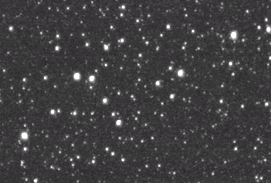New research on light flashes in the night sky may improve astronomical data

Quick flashes of light in the night sky have been linked to the growing mass of satellites and debris zipping around Earth’s orbit.
The orbital flashes, often mistaken for stars, occur 1,000 times an hour. A new study on this subject, led by the University of North Carolina at Chapel Hill (UNC-Chapel Hill), with the contribution of the researcher from the Institute of Space Studies of Catalonia (IEEC — Institut d’Estudis Espacials de Catalunya) at the Institute of Cosmos Sciences (ICC-UB), Octavi Fors, can improve the accuracy of astronomical data.
Stargazers have long been tantalized by the inexplicable glimmers and the study published last 5 November 2020 in The Astrophysical Journal Letters provides a potential explanation for those mysterious flashes.
Most of the flashes require powerful telescopes for viewing, but up to 100 of them are bright enough to see with the naked eye in a suburban community.
“Astronomical surveys have seen occasional reflected light glints from satellites; those flashes can cause false alarms in surveys looking for new events in the sky,” said lead study author Hank Corbett, graduate student at the UNC-Chapel Hill Department of Physics and Astronomy. “For the first time, we have studied the flashes in a systematic way that will help reduce their impact on astronomical discoveries.”, he added.
The team at UNC-Chapel Hill, along with collaborators from San Diego State University and the University of Barcelona, reported more than 100,000 flashes over a six-month period.
The flashes were observed with the Evryscopes, telescopes placed in California and Chile, constructed and funded by the US’ National Science Foundation. The pair of robotic, gigapixel-camera telescopes observe the entire sky above their observatories every two minutes.
“These measurements allow us to predict the impact of reflected-light flashes on both current and future professional observatories and develop techniques to mitigate their effects on data,” Corbett said.
The orbital flashes are reflected not only from the satellites relied on for navigation, communication, weather forecasting, and more, but also from space trash such as dead satellites, paint chips and errant nuts and bolts that have accumulated since space exploration began already six decades ago. These short duration flashes can be indistinguishable from stars in images from professional observatories and are typically visible for only a fraction of a second.
Rogue reflections from Earth satellites take two forms: short duration flashes that can lead to mistaken astrophysical events and streaks associated with fast-moving or slowly rotating satellites like SpaceX Starlink. Bright streaks caused by sun-illuminated satellites moving across an image are a separate class of events that needs to be studied.
Companies are competing to launch thousands of satellites capable of beaming internet coverage to Earth. However, in the new study, researchers conclude that the upcoming satellite internet constellations, like SpaceX Starlink, are unlikely to contribute significantly to the appearance of flashes, though there are other potential impacts of satellite constellations on astronomers.
Links
– IEEC
– ICC
– University of North Carolina at Chapel Hill
– Paper in The Astrophysical Journal Letters
More information
This research is presented in the paper “Orbital Foregrounds for Ultra-short Duration Transients”, by Hank Corbett et al., which was published in The Astrophysical Journal Letters on 5 November 2020.
The Institute of Space Studies of Catalonia (IEEC — Institut d’Estudis Espacials de Catalunya) promotes and coordinates space research and technology development in Catalonia for the benefit of society. IEEC fosters collaborations both locally and worldwide and is an efficient agent of knowledge, innovation and technology transfer. As a result of over 20 years of high-quality research, done in collaboration with major international organisations, IEEC ranks among the best international research centers, focusing on areas such as: astrophysics, cosmology, planetary science, and Earth Observation. IEEC’s engineering division develops instrumentation for ground- and space-based projects, and has extensive experience in working with private or public organisations from the aerospace and other innovation sectors.
IEEC is a private non-profit foundation, governed by a Board of Trustees composed of Generalitat de Catalunya and four other institutions that each have a research unit, which together constitute the core of IEEC R&D activity: the University of Barcelona (UB) with the research unit ICCUB — Institute of Cosmos Sciences; the Autonomous University of Barcelona (UAB) with the research unit CERES — Center of Space Studies and Research; the Polytechnic University of Catalonia (UPC) with the research unit CTE — Research Group in Space Sciences and Technologies; the Spanish Research Council (CSIC) with the research unit ICE — Institute of Space Sciences. IEEC is integrated in the CERCA network (Centres de Recerca de Catalunya).
Image
PR_Image1.gif: Fast flash
Caption: Have you seen mysterious flashes in the night sky that immediately disappear? The Evryscopes see thousands of quick reflections from satellites every night, one of which is illustrated here.
Contacts
IEEC Communication Office
Barcelona, Spain
Ana Montaner and Rosa Rodríguez
E-mail: comunicacio@ieec.cat
Lead Researcher at IEEC
Octavi Fors
Institute of Cosmos Science (ICC-UB)
Institute of Space Studies of Catalonia (IEEC)
Barcelona, Spain
E-mail: octavifors@icc.ub.edu
